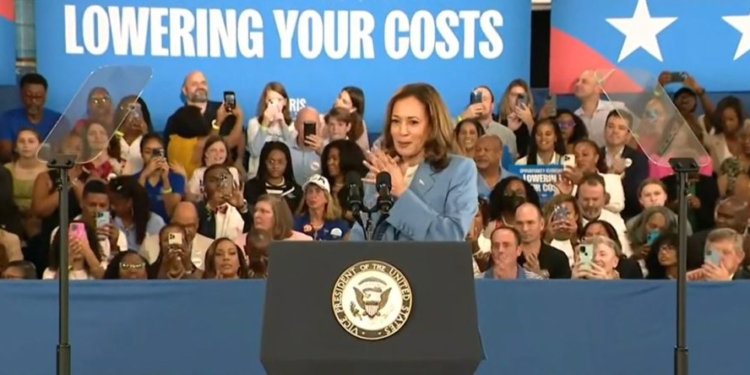How well is the Inflation Reduction Act working? The fact that, on its second anniversary, Vice President Kamala Harris plans to call for the federal government to ban grocery price gouging should give you your answer — it is not working.
Although her administration still takes credit for the laughably misnamed IRA, and the number of grocery stores ensures robust price competition, Harris’ proposal shows Americans are concerned about high prices.
Inflation has declined to 2.9% annually from over 8% in 2022, when the IRA was signed, but food prices are 21% higher than three years ago. Rather than reduce inflation, the IRA likely increased it, by giving tax credits to companies to produce more costly energy and transportation.
Along with inflation, tax credits have skyrocketed. When the IRA was signed into law, the U.S. Treasury Department estimated that tax credits would cost $270 billion over 10 years. But now Treasury reports that the 10-year cost of IRA tax credits is over $1 trillion, in line with estimates by Goldman Sachs.
These tax credits encourage development of wind and solar power, which raise electricity production costs, and make food more expensive. Intermittent energy is more expensive than continuous energy, because wind does not blow all the time and the sun does not always shine.
Wind farms need accompanying natural gas power plants to back them up, and solar arrays need backup batteries. Natural-gas power plants generate cheaper electricity running continuously than cycling on and off as wind stops blowing. But natural gas and coal plants are being pushed out by distortive renewable subsidies.
California’s regulations requiring wind and solar caused residential electricity prices to surge nearly 170%, from about 12 cents to 33 cents per kilowatt hour between 2004 and 2024. The U.S. average is about 16 cents.
Renewables require extensive transmission infrastructure to get energy to population centers. This will cost over $220 billion, according to the Department of Energy, and companies pass costs on to households through higher rates.
Similarly, electric vehicles (EVs) that get the $7,500 IRA tax credits are more expensive than gasoline-powered ones. The Ford F150 pickup truck XL costs $36,965, and the Ford Lightning pickup truck—the electric equivalent—costs $62,995.
Under the IRA, EVs were supposed to have a certain share of domestic production to get the credit, but a giant loophole exists for leased vehicles. The Treasury has ruled that commercial vehicles do not have to meet the domestic requirements to get the credit, and leased vehicles count as commercial. So, people can lease EVs and get the credit.
IRA tax credits were intended to benefit Americans and develop a domestic industry. But Chinese firms are partnering with American companies to try to get tax credits, as a result, the IRA is making China stronger and America weaker.
Ford and Contemporary Amperex Technology Co. Ltd. (CATL) have a joint enterprise in Michigan. Beijing will influence both the technology and the factory operations at the $2.5 billion plant, which is receiving $2.2 billion in tax incentives.
China dominates battery technology, accounting for over 70 percent of global electric vehicle battery production capacity, and CATL is the largest producer, profiting from close relations with the Chinese Communist Party (CCP).
One rationale for the IRA was to reduce emissions, but by many calculations, tax-favored renewables increase global emissions. Solar panels, wind turbines, and batteries made in China use electricity generated from coal-fired power plants. Emissions are generated when shipping components to Europe and the United States, as well as disposing of these panels and turbines when their usefulness is over.
As can be seen from Vice President Harris’ announcement, inflation is not fixed. The IRA likely made it worse by raising energy and transportation costs and putting domestic energy at a disadvantage. That is not a happy anniversary.
Diana Furchtgott-Roth serves as the Director of the Center for Energy, Climate, and Environment and The Herbert and Joyce Morgan Fellow in Energy and Environmental Policy at The Heritage Foundation. The Heritage Foundation is listed for identification purposes only. The views expressed in this article are the author’s own and do not reflect any institutional position for The Heritage Foundation, National Review Institute, or their Boards of Trustees.
The views and opinions expressed in this commentary are those of the author and do not reflect the official position of the Daily Caller News Foundation.
Featured Image: Screen Capture/CSPAN
All content created by the Daily Caller News Foundation, an independent and nonpartisan newswire service, is available without charge to any legitimate news publisher that can provide a large audience. All republished articles must include our logo, our reporter’s byline and their DCNF affiliation. For any questions about our guidelines or partnering with us, please contact [email protected].


























